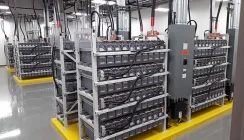A Preventative Maintenance Checklist for Datacentre UPS Batteries
Almost every business and organisation will have an IT element that will be protected with an uninterruptible power supply. Whether it’s a server room or data centre UPS or smaller system protecting a single server or IoT element, the amount of runtime available will depend on the ‘health’ of the UPS batteries.
Whilst a UPS system will include some form of battery monitoring, nothing tests a UPS battery as much as putting it under load i.e. simulating a complete mains power failure and running the system in this mode for several minutes. One of the reasons for this is that a battery can test out as ‘healthy’, but its voltage and capacity rapidly fall under a full-load discharge. So if the battery monitoring circuit within an uninterruptible power supply only provides a ‘health’ indication what preventative maintenance measures are available to ensure that your UPS batteries will be capable of delivering their full-rated power in an emergency?
UPS Battery Design Life
Most UPS batteries are of the valve regulated lead acid (VRLA) or as they are also known maintenance free lead acid type. This type of battery is suitable for standby power applications and is also used in emergency lighting, security and alarm panels, and generator starter motors. Lead acid batteries are generally of two types: 5-year and 10-year design life and it is rare for either type to reach their expected design life. Why?
There are several factors that can affect a lead acid battery in a UPS system application, and these include:
- Battery Age: lead acid batteries store and discharge electrical energy using a chemical process reliant on the interaction between lead plates (positive and negative) and a hydrochloric acid gel electrolyte. As a battery ages, its electrical performance deteriorates due to a rising impedance (internal resistance) and sulfation (a build-up of sulfate crystals).
- Rack and Server Room Ambient: the ambient temperature around a UPS battery is important as the higher the temperature, the faster the battery ages. The ideal temperature is 20-25˚C and for each degree rise above 30, the design life halves. Ambient temperatures can be found to vary considerably within server rooms and within server racks themselves and the correct placement of a UPS within these types of environment is critical to the long-term health of the battery. In a datacentre environment there is generally a more controlled environment and the UPS may even be placed with a separate and temperature controlled plant room.
- Charge/Discharge Cycle Number: most lead acid batteries are designed for 300-500 complete cycles. In areas with an unstable mains power supply, continuous cycling of the battery will lead to the need for early replacement. It is for this reason that UPS lead batteries are generally not recommended for energy storage applications. For energy storage the lead acid battery must be specified to a different cycling specification. The preferred battery for energy storage is lithium-ion due to its fast recharge, power density and cycling capacity.
- Load Size: most UPS batteries are sized up to 80% of the capacity of the UPS system. The larger the battery Ah-rating compared to the load-size, the less likely that it will be run at near capacity and in practice the longer the runtime and working-life expectancy. Server room and datacentre loads are rarely static. The UPS and its battery should therefore be sized for future growth capacity. This is somewhat easier with a modular UPS but unless the battery is modular, the battery Ah-capacity may be fixed from day one of the installation. As more load is added, the potential runtime of the UPS battery will reduce.
- Humidity and Air Purity: these environmental factors may be more applicable to industrial UPS applications or uninterruptible power supplies used within more tropical environments. Humidity won’t necessarily affect UPS battery performance, assuming the room is cooled to 20-25˚C as mentioned, but a high humidity could lead to corrosion and the necessity to replace other consumables more regularly including cooling fans. Dusty, fume and smoky conditions should also be avoided as the can lead to similar UPS operational performance issues, unless the system is designed for such environments.
Any of these factors can lead to problems with UPS batteries and their need for replacement. There are however preventative measures that can be taken during the working life of an uninterruptible power supply.
For more information on how lead acid batteries work see: https://www.electronics-notes.com/articles/electronic_components/battery-technology/how-do-lead-acid-batteries-work-technology.php
UPS Battery Preventative Maintenance and Inspections
Most UPS systems will be under some form of UPS maintenance contract and will generally have at least one preventative maintenance visit per annum. During this onsite visit certain checks can be made to ensure that the UPS battery set is in a healthy and fully available condition.
- Battery Visual Inspections: as with any preventative maintenance, a visual inspection can give visual clues as to the operational state of the UPS battery. Lead acid batteries typically have a plastic case and as the battery ages, the internal heat build-up due to impedance and sulfation can lead to the case buckling or at worst case cracking. White powder residue around the positive and/or negative terminal poles can also indicate internal problems. If there is a dust or dirt build-up then this could be considered for removal if there is a safe way to isolate the battery set for safe working and protection from an accidental discharge or short-circuit.
- Battery Block Testing: using a hand-held battery tester, each individual battery block can be tested. There are generally two types of tester: impedance or the more sophisticated conductance type. Each battery block is given a unique identifier and the readings from subsequent battery inspection visits can be plotted to provide a health trend and help to identify failing battery blocks.
- Battery Capacity and Load Bank Testing: most large datacentre UPS are subject to load bank testing during the commissioning stage. Load bank tests can also form part of a regular preventative maintenance visit either annually or every 3-5 years. Load bank testing is more comprehensive than individual battery block testing, as the mains power supply to the UPS is ‘cut’ the battery placed under dummy load. The amount of runtime available for a given kVA/kW rating can be recorded and compared to specification.
During years 1 and 2 of UPS operation, visual inspections together with analysis of the UPS log files may be considered appropriate for most server loads. Within a datacentre UPS application, annual battery block testing may form part of the overall UPS maintenance contract with provision for load- bank testing if there is a sudden change in readings or the battery is approaching 70-80% of its design life.
UPS Battery Monitoring Systems
Another option is to consider the use of a permanent UPS battery monitoring system. This type of arrangement uses individual battery block sensors connected to a battery management system (BMS). Live and historical readings are made available over a network or cloud portal with alerts issued via email and SMS text for measurement changes outside pre-set values or sudden failures. This type of battery monitoring is typically used with larger hyperscale datacentres.
Lithium-ion UPS Battery Replacements
Lithium-ion battery technology and its application in energy storage systems is driving some UPS manufacturers to offer this type of battery as an alternative backup solution to lead acid. Lithium batteries pack a far higher power density and this can help to reduce the space required for an uninterruptible power supply battery pack in a datacentre and or within a UPS case. Lithium-ion batteries also charge far faster than lead acid (80% within 1-2 hours compared to 80% within 24 hours) and are capable of almost unlimited charge/discharge cycles. However, as in any other lithium-ion battery application, there is the need for a more complex (and therefore costly) battery management system. This can lead to larger datacentre UPS systems with lithium-ion having a 30% premium over their lead acid battery alternatives. As take-up of the li-ion type batteries increases, through their adoption in transportation and energy storage (e.g. solar PV/wind turbine), then this ‘price-gap’ should start to close rapidly.
Summary
There are several ways you can protect your UPS batteries and ensure that they reach their expected working life. This is important from two aspects. Firstly, batteries are costly items to replace in terms of material and labour costs and these should be factored into Total Cost of Ownership (TCO) calculations. Secondly, the less the need for battery replacement during the working life of a UPS system, the more sustainable and environmentally friendly the installation. Whilst up to 90% or more of a lead acid battery can be recycled, lead is a limited resource and the plastic case of battery is made from carbon-based materials.


























